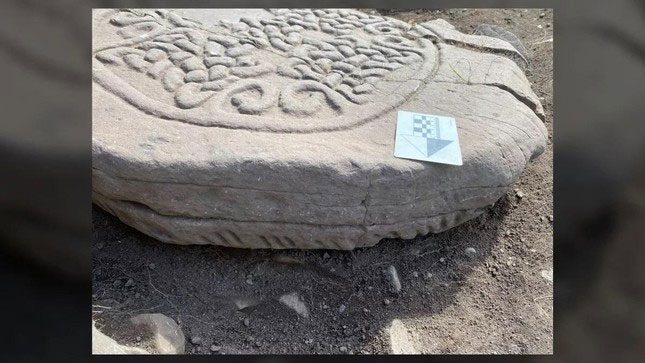Archaeologists and volunteers have discovered a stone slab inscribed with mysterious writings and carvings of birds, crafted by the Picts of Scotland over a millennium ago.
The Picts, or “the painted ones”, were named by Roman historians due to their war paint and tattoos (“picti,” is the Latin term meaning “painted”). They inhabited the northern and eastern regions of Scotland during the early Middle Ages. Possibly descendants of Celtic tribes, the Picts are renowned for successfully resisting Roman conquest. While the Romans viewed the Picts as barbaric and primitive, they were primarily self-sufficient farmers who cultivated grains and raised domesticated livestock.

Close-up of the inscription on the stone.
After the Roman Empire withdrew from Britain in the fifth century AD, Pictish society evolved to establish a permanent but unstable monarchy aimed at protecting its territorial borders. Early missionaries from Ireland converted many Pictish kings to Christianity by the mid-sixth century AD. Later, in the Battle of Dun Nechtain in 685 AD, the Picts expelled the English from Scotland, creating a small empire that lasted until around 900 AD, coinciding with the arrival of the Vikings.
However, the newly discovered cross slab, found in the Old Kilmadock cemetery near Doune, Scotland—a region historically serving as a buffer zone between the Picts and the Romans, and later the English—provides a different perspective on the Pictish presence.
Archaeologist Murray Cook from Stirling Council stated: “The cross slab is the first artifact found in this area, and it may indicate that the residents began to identify themselves as Picts.”
Carved stones from the early Middle Ages in Scotland are relatively common, but the newly discovered stone from Old Kilmadock features three intriguing characteristics: a rounded top, animal decorations, and an inscription written in a medieval alphabet known as ogham.
Kelly Kilpatrick, a historian and Celtic scholar at the University of Glasgow, noted that cross slabs could be significant markers used to convey Christian messages.
An ogham inscription running around the face of the slab has astonished researchers. Ogham was used to write an early version of the Irish language, formed by creating parallel strokes and diagonal lines along a central axis. About 400 of these inscriptions have survived to date, mainly in Ireland, but the inscription from Old Kilmadock is the first found in central Scotland.
Three additional inscribed stones were discovered in two different alphabets. This suggests that there was a literate and educated religious community, possibly indicating the presence of a monastery.




















































